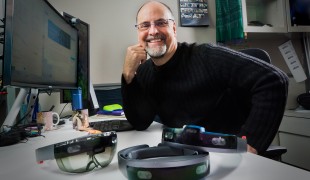- 4538
- 275
- 17
- 13
- 0
- Help Ukraine
About the solution
Deaf concertgoers often face limited access to the sonic experience. A remarkable solution has emerged, transforming the way music is perceived by all. This creation, called "Music: Not Impossible," was born from the desire to provide a unique and nuanced music experience, inspired by the deaf community.
Daniel Belquer, a musician and theater artist, took on the role of "Chief Vibrational Officer" at Music: Not Impossible, an initiative of Not Impossible Labs. Not Impossible Labs leverages new technologies to address social issues like poverty and disability access. Their venture aimed to enhance the concert-going experience by translating live music into physical vibrations on the skin in real-time.
To ensure the authenticity and effectiveness of their creation, the team collaborated closely with Mandy Harvey, a deaf singer/songwriter. Mandy's valuable feedback throughout the development process ensured that Music: Not Impossible stayed true to its inspiration, enhancing the experiences of deaf and hard-of-hearing concert attendees.
The journey to achieving their goal was filled with challenges. Initial attempts involved attaching vibrating cell phone motors to the body, but these proved inadequate, lacking variety and nuance in capturing the richness of the music. Undeterred, the team sought the expertise of engineers at Avnet, an electronic components company. Together, they designed a lightweight haptic suit with 24 actuators, or vibrating plates. The vest, resembling a snug hiking backpack, featured 20 actuators, while the remaining four were placed on the wrists and ankles.
Wearing the haptic suit, the sensations on the skin were extraordinary, bringing textures to life: raindrops on the shoulders, tickles across the ribs, and thumps against the lower back. These vibrations went beyond replicating the music; they were carefully crafted to play waves of sensation in harmony with the musical composition, complementing the auditory experience in a profound way.
To celebrate this innovation, an inclusive event took place during Lincoln Center's annual Summer for the City festival, specifically honoring Disability Pride Month. The organizers spared no effort in creating an environment that catered to various disabilities. American Sign Language interpreters were present, and the music was captioned on a stage screen. Audio descriptions served the visually impaired, while a dedicated chill-out space offered noise-reducing headphones, earplugs, and fidgets to combat overstimulation. The event embraced the concept of a silent disco, with music exclusively experienced through headphones, allowing attendees to adjust the volume to their preference.
Adapted from:
https://www.npr.org/2023/07/17/1186173942/vibrating-haptic-suits-give-de...
https://www.notimpossible.com/projects/music-not-impossible
https://www.youtube.com/watch?v=0GwCbTXp07Y
This solution shall not include mention to the use of drugs, chemicals or biologicals (including food); invasive devices; offensive, commercial or inherently dangerous content. This solution was not medically validated. Proceed with caution! If you have any doubts, please consult with a health professional.
DISCLAIMER: This story was written by someone who is not the author of the solution, therefore please be advised that, although it was written with the utmost respect for the innovation and the innovator, there can be some incorrect statements. If you find any errors please contact the patient Innovation team via info@patient-innovation.com
-
-
378
-
0
-
4278

Using AI to allow blind people to find familiar faces
COMMUNICATION: Communicating, whether by speaking, listening, or other means
Social interaction
Blindness
5 Senses support devices: (glasses, hearing aids, headphones...)
Body-Worn solutions (Clothing, accessories, shoes, sensors...)
App (Including when connected with wearable)
AI algorithm
Assistive Daily Life Device (to help ADL)
Difficulty communicating with environment
Confusion
Regaining sensory function
Promoting self-management
Promoting inclusivity and social integration
Improving Speech and Communication
Raise awareness
Ophthalmology
Pediatrics
United States
-
-
-
581
-
0
-
10960

Pedro, an acoustic engineer designed an open-ear hearable device in order to allow everyone to listen to music!
COMMUNICATION: Communicating, whether by speaking, listening, or other means
Hearing Disorders
5 Senses support devices: (glasses, hearing aids, headphones...)
Assistive Technology access
Body-Worn solutions (Clothing, accessories, shoes, sensors...)
Regaining sensory function
Promoting self-management
Promoting inclusivity and social integration
Improving Speech and Communication
Raise awareness
General and Family Medicine
Internal Medicine
Neurology
Otorhinolaryngology
Denmark
-
-
-
290
-
0
-
3875

Patient creates the Finsen Headphones, a device to detect and treat ear infections
COMMUNICATION: Communicating, whether by speaking, listening, or other means
5 Senses support devices: (glasses, hearing aids, headphones...)
Regaining sensory function
Managing pain
To implement a diagnostic tool
To improve Treatment/Therapy
Preventing (Vaccination, Protection, Falls, Research/Mapping)
Otorhinolaryngology
United States
-
 en
en